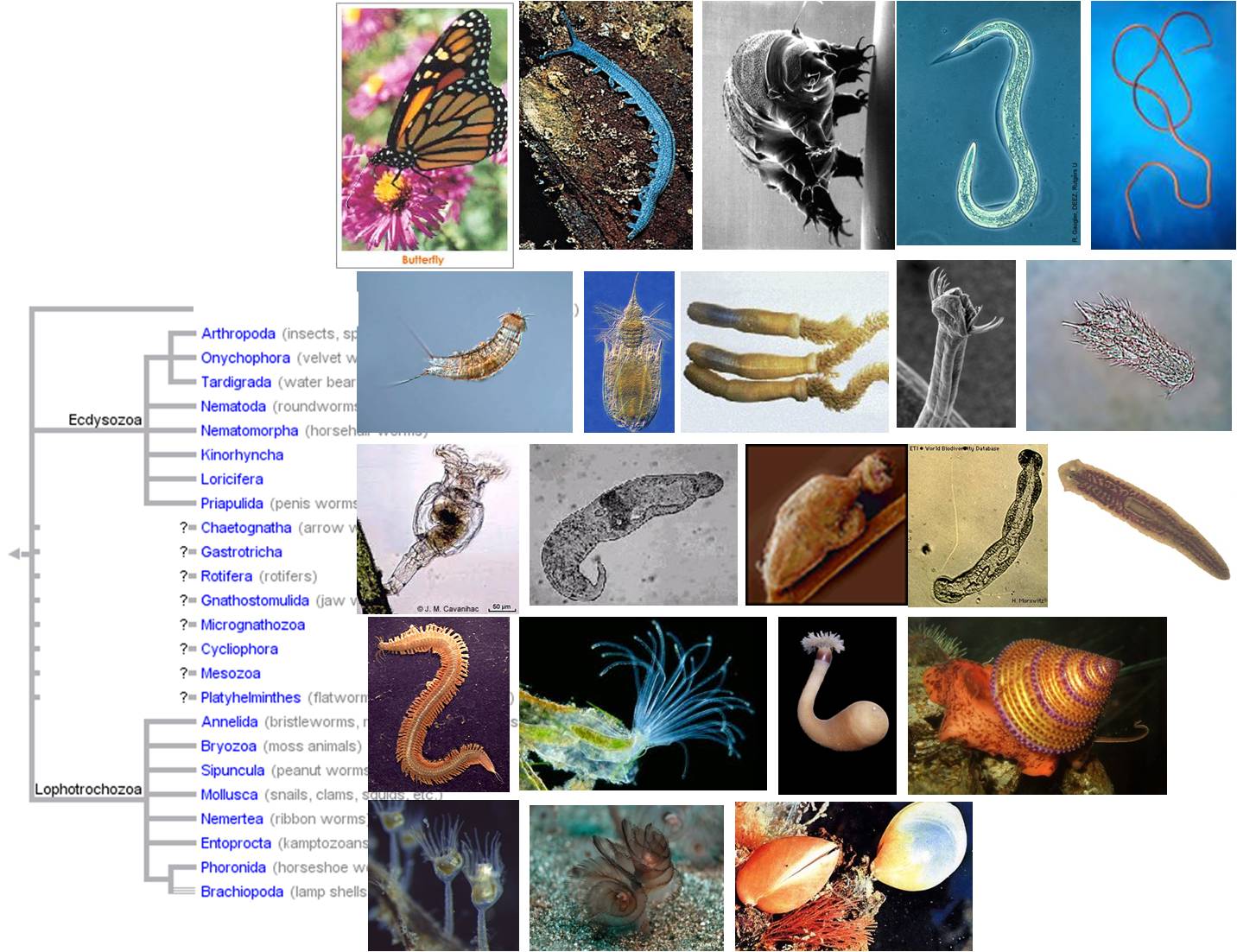 The
Diversity of Life
The
Diversity of Life  The
Diversity of Life
The
Diversity of Life
l. Phylum Chordata: Vertebrates
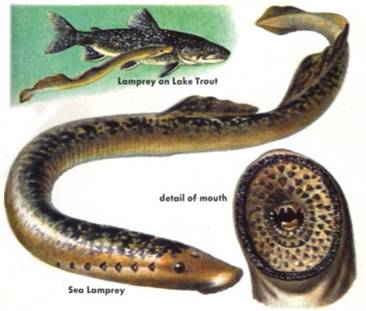
Vertebrates represent the evolutionary lineage that went in the other direction: not towards a sedentary lifestyle but towards an active lifestyle. For the remainder of this unit, we will look at the evolutionary radiations within the vertebrates. We will see a typical pattern throughout this unit. A new group will evolve a novel trait or way of life. This will allow it to use a new environment, or use the environment in a new way. These lifestyles are called "adaptive zones", and they relate to ecological niches. Creation or entry into a new niche or zone means that there is no competition for resources. Under these conditions, almost any strategy using this new novel innovation will work - typically we see a radiation of new species exploiting this new way of life. As this adaptive zone or niche fills with species, they begin to compete. This leads to 'competitive contraction' of diversity, with only a few winners. The same thing happens in any situation where there are potentially limted resources. A new innovation, like the internet, provides opportunities to new businesses. Many flourish initially - like the many browser providers that were present in the '90's. Anyone remember when Netscape was the primary internet provider? Economists call that period the "dot-com boom", when internet companies could get a start just by colonizing this new open marketplace. As companies grew, they began to compete; and there were winners that maintained their position in the niche, and losers that went extinct. The same thing can happen in ecological systems. Competitive contraction can occur within a clade, or as a consequence of a more efficient, new evolutionary novelty arising. Henry Ford's Model T not only put many other car makers out of business, it also puts LOTS of horse-driven carriage companies out of business! So, as a more advanced, efficient group evolves, we sometimes see contraction in the abundance of ancestral forms... just as Darwin predicted.
 The
jawless fishes: The vertebrates are distinguished by having an internal supportive spine that
is subdivided into units called vertebrae. This segmentation of the vertebral
column allows the animal to bend and move with more precision; with some parts
of the body moving while other parts remain stationary. The most primitive members
of this clade are the jawless fishes. The modern representatives are the hagfish
and the lampreys. The hagfish actually lack a subdivided vertebral column, but
they do have a skull surrounding their brain. As such, sometimes the "vertebrata"
are more specifically described as having a skull (to include the hagfish).
Both hagfish and lampreys have immature stages that look almost identical to
cephalochordates, also suggesting their primitive position within this clade.
So, the jawless fish evolve in the Cambrian and radiate in the Ordovician and
Silurian Periods, with many large, detritivorous and filter feeding species
scouring the benthos for food. In more advanced forms, the mouth cavity and
pharynx evolved for feeding, relieving the gills of this filtering function.
These jawless fish probably sucked in small invertebrates by rapidly opening
their mouth.
The
jawless fishes: The vertebrates are distinguished by having an internal supportive spine that
is subdivided into units called vertebrae. This segmentation of the vertebral
column allows the animal to bend and move with more precision; with some parts
of the body moving while other parts remain stationary. The most primitive members
of this clade are the jawless fishes. The modern representatives are the hagfish
and the lampreys. The hagfish actually lack a subdivided vertebral column, but
they do have a skull surrounding their brain. As such, sometimes the "vertebrata"
are more specifically described as having a skull (to include the hagfish).
Both hagfish and lampreys have immature stages that look almost identical to
cephalochordates, also suggesting their primitive position within this clade.
So, the jawless fish evolve in the Cambrian and radiate in the Ordovician and
Silurian Periods, with many large, detritivorous and filter feeding species
scouring the benthos for food. In more advanced forms, the mouth cavity and
pharynx evolved for feeding, relieving the gills of this filtering function.
These jawless fish probably sucked in small invertebrates by rapidly opening
their mouth.
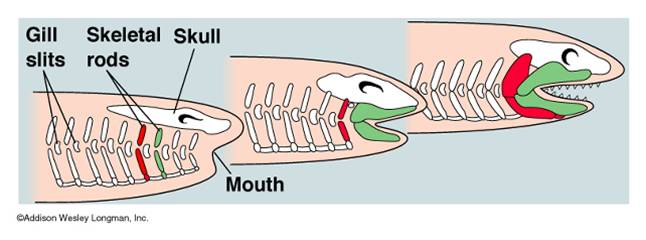 The
Gnathostomes: The Jawed Vertebrates: Jawed fishes evolved
in the Silurian and came to dominate and radiate in the Devonian - the "Age
of Fishes". Jaws evolved from the anterior gill arches, which flex and
became associated withe the mouth. Jaws allowed fish to become more efficient
predators, killing things bigger than could fit in their mouth through suction,
or strong enough to escape the suctioning force. In short, jaws were adaptive
because fish now became mobile, active predators - entering a niche previously
only occupied by large invertebrate predators. The first jawed fish radiation
were the placoderms, symbolized by the frightening Arthrodire predators like Dunkleosteus, with its huge slicing jaw plates. The placoderms were
very heavy, however, and were displaced by more efficient swimmers - the cartilaginous
jawed fishes (Class Chondrichthyes). Modern representatives of this group are
sharks and rays.
The
Gnathostomes: The Jawed Vertebrates: Jawed fishes evolved
in the Silurian and came to dominate and radiate in the Devonian - the "Age
of Fishes". Jaws evolved from the anterior gill arches, which flex and
became associated withe the mouth. Jaws allowed fish to become more efficient
predators, killing things bigger than could fit in their mouth through suction,
or strong enough to escape the suctioning force. In short, jaws were adaptive
because fish now became mobile, active predators - entering a niche previously
only occupied by large invertebrate predators. The first jawed fish radiation
were the placoderms, symbolized by the frightening Arthrodire predators like Dunkleosteus, with its huge slicing jaw plates. The placoderms were
very heavy, however, and were displaced by more efficient swimmers - the cartilaginous
jawed fishes (Class Chondrichthyes). Modern representatives of this group are
sharks and rays.
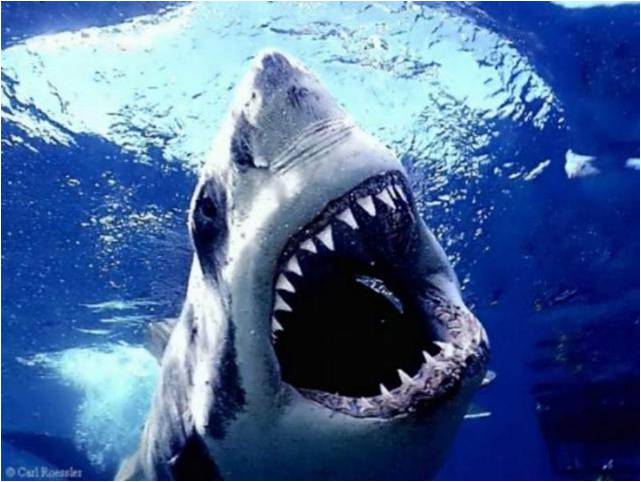 The
Devonian also saw the radiation of the most successful group of fish on earth,
the bony fish (Class Osteichthyes). Unlike cartilage, bone is hollow and light;
it is also more rigid than cartilage, providing more resistance and efficiency
to muscles. The bony fish also had a swim bladder, whcih they used to maintain
neutral bouyancy in the water column. This means that they can maintain position
without swimming; Condrichthyes must swim to maintain vertical position in the
water column - otherwise they sink. These two adaptations of the bony fishes
made them more energetically efficient and faster than the cartilaginous fish,
and the bony fishes have radiated to the point where they represent 40% of all
vertebrate species today (not just fish - vertebrates..!!). Two important clades
evolved within the bony fishes: 1) the ray-finned fishes that came to dominate
the aquatic environments of the planet; and 2) the lob-finned fishes that radiated
into shallow-water environments. The lobe-finned fishes, swimming in shallow,
oxygen-poor waters of the Devonian, gulping air at the surface and pulling themselves
along on their forefins, evolved into the terrestrial tetrapods. Arthropods
had already colonized land, so there was ample food and oxygen for a large terrestrial
predator. As you have seen, the fossil record nicely documents the transition
from fish to these primitive amphibians.
The
Devonian also saw the radiation of the most successful group of fish on earth,
the bony fish (Class Osteichthyes). Unlike cartilage, bone is hollow and light;
it is also more rigid than cartilage, providing more resistance and efficiency
to muscles. The bony fish also had a swim bladder, whcih they used to maintain
neutral bouyancy in the water column. This means that they can maintain position
without swimming; Condrichthyes must swim to maintain vertical position in the
water column - otherwise they sink. These two adaptations of the bony fishes
made them more energetically efficient and faster than the cartilaginous fish,
and the bony fishes have radiated to the point where they represent 40% of all
vertebrate species today (not just fish - vertebrates..!!). Two important clades
evolved within the bony fishes: 1) the ray-finned fishes that came to dominate
the aquatic environments of the planet; and 2) the lob-finned fishes that radiated
into shallow-water environments. The lobe-finned fishes, swimming in shallow,
oxygen-poor waters of the Devonian, gulping air at the surface and pulling themselves
along on their forefins, evolved into the terrestrial tetrapods. Arthropods
had already colonized land, so there was ample food and oxygen for a large terrestrial
predator. As you have seen, the fossil record nicely documents the transition
from fish to these primitive amphibians.
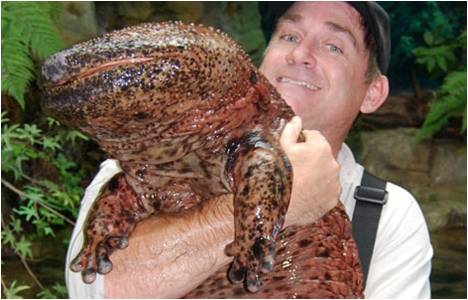 The
Tetrapods: The
tetrapod clade includes all vertebrates descended from the first animals to
walk on land. The radiation of early tetrapods is very impressive; the adaptive
zone of the Carboniferous swamps was very large and well-suited to amphibian
animals reliant on water to lay their eggs. In addition, the huge amount of
biological productivity (lots of photosynthesis and less decompostion, remember?)
led to large populations of herbivorous insects that were eay prey for large
land vertebrates. The Carboniferous could well be called the "Age of Amphibians".
Many groups of early 'amphibians' radiate during this period, collectively called
the 'stem tetrapods'. However, the dry periods of the Permian and Mesozoic were
not optimal for these animals limited to areas near water. Today, three groups
of amphibians remain. The Caecilians are unusual, rare, legless amphibians.
Salamanders are the second group, and the giant Japanese salamander is the largest
living amphibian - reaching six feet in length! The most diverse group is the
Anura - mening "tailless" - the frogs and toads. Most amphibians have
gills or lungs at some point in their life cycle, but many also (or exclusively)
respire through their skin. For this to happen, the gases must diffuse into
a thin film of water, and then move across cell membranes by diffusion. So,
most amphibians need to keep their skin moist to respire; and it also means
that their skin, as an absorptive surface, is also prone to absorb toxins in
the environment. For these reasons, amphibians are particularly sensitive to
pollutants and environmental contaminants. Over the last 50 years, there has
been a dramatic decline in amphibian populations worldwide, probably due to
exposure to human-produced pollution, climate change, and chytrid fungal infections.
It is tough to say which of these variables is 'most' responsible for the decline.
In all likelihood, each factor increases sensitivity to the other two. In any
case, these three factors are having a decimating effect on amphibian populations.
The
Tetrapods: The
tetrapod clade includes all vertebrates descended from the first animals to
walk on land. The radiation of early tetrapods is very impressive; the adaptive
zone of the Carboniferous swamps was very large and well-suited to amphibian
animals reliant on water to lay their eggs. In addition, the huge amount of
biological productivity (lots of photosynthesis and less decompostion, remember?)
led to large populations of herbivorous insects that were eay prey for large
land vertebrates. The Carboniferous could well be called the "Age of Amphibians".
Many groups of early 'amphibians' radiate during this period, collectively called
the 'stem tetrapods'. However, the dry periods of the Permian and Mesozoic were
not optimal for these animals limited to areas near water. Today, three groups
of amphibians remain. The Caecilians are unusual, rare, legless amphibians.
Salamanders are the second group, and the giant Japanese salamander is the largest
living amphibian - reaching six feet in length! The most diverse group is the
Anura - mening "tailless" - the frogs and toads. Most amphibians have
gills or lungs at some point in their life cycle, but many also (or exclusively)
respire through their skin. For this to happen, the gases must diffuse into
a thin film of water, and then move across cell membranes by diffusion. So,
most amphibians need to keep their skin moist to respire; and it also means
that their skin, as an absorptive surface, is also prone to absorb toxins in
the environment. For these reasons, amphibians are particularly sensitive to
pollutants and environmental contaminants. Over the last 50 years, there has
been a dramatic decline in amphibian populations worldwide, probably due to
exposure to human-produced pollution, climate change, and chytrid fungal infections.
It is tough to say which of these variables is 'most' responsible for the decline.
In all likelihood, each factor increases sensitivity to the other two. In any
case, these three factors are having a decimating effect on amphibian populations.
The Amniota: Within the tetrapods, a new type of animal evolved in the Carboniferous; an animal that laid an egg surrounded by a series of membranes and a shell. These layers served to protect the developing embryo and yolk sac from dessication, allowing these species to colonize land further from water and exploit food resources and habitats that amphibians could not reach. This clade of animals is the amniotes, and their evolutionary innovation is the amniotic egg. The primitive condition within this group probably produced a leathery covering, much like turtles. A more rigid, desiccation resistant egg like birds have is probably a derived trait, as is the retention of the egg and live bearing of young, as seen in some snakes, and most mammals. The amniotes radiated during the Permian Period, when the drying of the unified land mass of Pangaea gave them a decided advantage over the ancestral, amphibious tetrapods. Three groups evolved at this time, distinguished by their skull morphology.
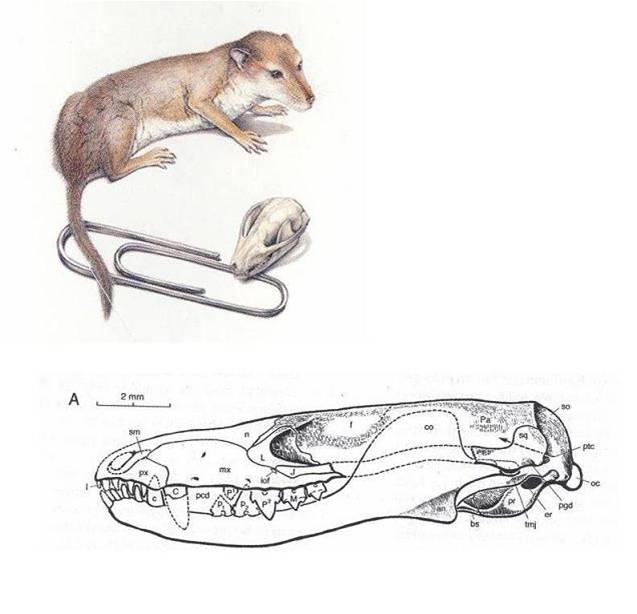 The
Synapsids and the Mammals: The first group to dominate
were the synapsids. They dominated during the Permian, and were represented
by the great "sail-finned" Pelycosaurs and the Therapsid lineages
(the Gorgonopsians, the Dicynodonts, and the Cynodonts). The synapsid lineage
that is alive today are the Mammals. The transition from ancestral to derive
synapsids is well preserved in the fossil record, documenting the evolution
of the inner ear from the ancestral jaw bones, and the evolution of complex
and specialized dentition. The first true mammals are the Morganucodonts that
evolved in the Jurassic Period of the Mesozoic, about 200 mya. Ancestral synapsids
were large carnivores that dominated the landscape; a niche that would be filled
by the diapsid dinosaurs during the Mesozoic. The mammals were small, noctural
insectivores and scavengers. They radiated into these niches in the Jurassic,
perhaps because their endothermy allowed them to use the cool night more effectively
and under cover of darkness from larger predators. The surviving lineage of
this radiation are the three species of monotremes alive today: the platypus
and two species of echidna. These mammals lay eggs. Their offspring hatch, and
then nuzzle the belly of their mothers. Their mothers have sweat glands that
have evolved to produce a nutrient rich milk - they are mammary glands. However,
even the modern representatives lack nipples on these glands - so they "sweat"
milk onto their belly and the the hatchlings lick it up. Placental and marsupial
mammals evolved later, in the Cretaceous Period. Marsupials do not lay eggs;
they give live birth to a very small, embryonic newborn. The newborn climbs
from the genital opening to the pouch - a flap of skin covering the nipples
of the mammary glands. The embryo attaches to a nipple and feeds nearly continuously,
completing development in the pouch. This allows the mother to carry the embryo
with her for a longer period; there are no eggs that must be left periodically
for the mother to feed. The last group of mammals, the placentals, also retain
the embryo and give live birth. However, they retain the embryo much longer,
often until the offspring is capable of independent activity. The efficient
feeding of the embryo is facilitated by the placenta - which allows nutrients
in the bloodstream of the mother to pass directly into the bloodstream of the
offspring. This is far more efficient, energetically, than the mother turning
the nutrients into milk, that must be consumed and digested by the offspring.
So, placental mammals can develop more rapidly than marsupials. Some placentals
produce offspring that can walk immediately; these are precocial young. Other
species, like cats and humans, produce offspring that still need considerable
parental care. These offspring are called altricial.
The
Synapsids and the Mammals: The first group to dominate
were the synapsids. They dominated during the Permian, and were represented
by the great "sail-finned" Pelycosaurs and the Therapsid lineages
(the Gorgonopsians, the Dicynodonts, and the Cynodonts). The synapsid lineage
that is alive today are the Mammals. The transition from ancestral to derive
synapsids is well preserved in the fossil record, documenting the evolution
of the inner ear from the ancestral jaw bones, and the evolution of complex
and specialized dentition. The first true mammals are the Morganucodonts that
evolved in the Jurassic Period of the Mesozoic, about 200 mya. Ancestral synapsids
were large carnivores that dominated the landscape; a niche that would be filled
by the diapsid dinosaurs during the Mesozoic. The mammals were small, noctural
insectivores and scavengers. They radiated into these niches in the Jurassic,
perhaps because their endothermy allowed them to use the cool night more effectively
and under cover of darkness from larger predators. The surviving lineage of
this radiation are the three species of monotremes alive today: the platypus
and two species of echidna. These mammals lay eggs. Their offspring hatch, and
then nuzzle the belly of their mothers. Their mothers have sweat glands that
have evolved to produce a nutrient rich milk - they are mammary glands. However,
even the modern representatives lack nipples on these glands - so they "sweat"
milk onto their belly and the the hatchlings lick it up. Placental and marsupial
mammals evolved later, in the Cretaceous Period. Marsupials do not lay eggs;
they give live birth to a very small, embryonic newborn. The newborn climbs
from the genital opening to the pouch - a flap of skin covering the nipples
of the mammary glands. The embryo attaches to a nipple and feeds nearly continuously,
completing development in the pouch. This allows the mother to carry the embryo
with her for a longer period; there are no eggs that must be left periodically
for the mother to feed. The last group of mammals, the placentals, also retain
the embryo and give live birth. However, they retain the embryo much longer,
often until the offspring is capable of independent activity. The efficient
feeding of the embryo is facilitated by the placenta - which allows nutrients
in the bloodstream of the mother to pass directly into the bloodstream of the
offspring. This is far more efficient, energetically, than the mother turning
the nutrients into milk, that must be consumed and digested by the offspring.
So, placental mammals can develop more rapidly than marsupials. Some placentals
produce offspring that can walk immediately; these are precocial young. Other
species, like cats and humans, produce offspring that still need considerable
parental care. These offspring are called altricial.
The Diapsids: The other major group of amniotes are the diapsids. They radiated into two major groups, the lepidosaurs that walked with their legs splayed out and the archosaurs that walked with their legs underneath.
The archosaurs would dominate during the Mesozoic Era, with the great radations of the Crocodylomorphs, Pterosaurs, and Dinosaurs. Two groups of Archosaurs persists today - the crocodilians (caimen, gavials, alligators, and crocodiles), and the birds. Although several groups of dinosaurs evolved feathers - probably first for attracting mates or communicating, and then for insulation - only in the birds did these feathers evolve for powered flight. Associated shared derived characters are light, hollow, fused bones, the fusion of digits in the forelimbss, a keeled sternum for anchoring large breast muscles used for flight, and a 'wishbone' - a union of the two clavicles that acts like a spring during the flight stroke. The loss of teeth is also a derived trait in this group, as is the evolution of an interesting respiratory system of air sacs. Birds have a one way lung. Air that's inhaled goes to a posterior air sac. On the first exhalation, air is moved forward through the lung. The second inhalation refills the posterior air sac, and the next exhalation pulls deoxygenated air forward into the anterior air sac and out of the animal. This modification, like a one-way digestive tract, improves the efficiency of the organ. Now, the air in the lung is always oxygenated; it is not mixed with deoxygenated air like in the sac-like lungs of other animals. It's not surprizing that birds would evolve this system, as the metabolic demands of flight are much more significant than other forms of locomotion.
1. Introduction: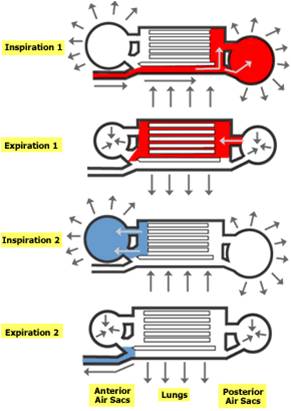
Human evolution provides great examples of many of the themes that we have been discussing in this last unit, including the themes of classification vs. phylogenetics, developmental genetics and evolution, and the sequence of innovation, radiation, and competitive contraction.
Humans are primates; primates are mammals with grasping hands and forward facing eyes. Humans are further classified in the superfamily Hominoidea - generally equivalent to the term "apes". These are primates that lack tails, and also include the gibbons, orangutan, gorillas, and chimpanzees. (Some macaques lack tails, also, but are not apes.) Previous to recent genetic analyses, apes were classified in families (taxonomic categories with the suffix "-idae") like this: Hominidae (humans), Pongidae (chimps, gorillas, and orangutans), and Hylobatidae (gibbons). Now, given the knowledge that chimps and gorillas are more closely related to humans than to orangutans, the phylogeny is described as follows: Hominidae (humans, chimps, gorillas, orangutan), and Hylobatidae (gibbons).
Although the degree of genetic difference reported between humans and chimpanzees tends to vary depending on the genomic regions compared, in general there is about a 1-4% difference in DNA sequence between chimpanzee species and humans. In many respects, this seems like a remarkably SMALL difference - especially considering the dramatic differences between these species in morphology and behavior. I mean, think about it. You are reading a complex language, displayed on a screen through computer programs powered by electricity, generated by a nuclear power station - all conceived, designed, built and run by people. The extent of chimpanzee technology is pulling the leaves off a stem, so the stem will fit in the holes in a termite mound to extract termites. That is one big behavioral gulf.
So, that begs the following question: "can we really explain the differences in morphology and behavior with only a 1-4% change in DNA?" In short, can this small amount of genetic change cause the differences we see? To get a handle on whether this is possible, we should describe the patterns more completely - how do these species differ morphologically and behaviorally, and does that suggest a particular genetic explanation?
2. Patterns
 a.
Morphological and Behavioral
a.
Morphological and Behavioral
Humans differ from chimps and gorillas in several obvious morphological and behavioral ways. Morphologically, humans have a larger head-to-body ratio, a small jaw-to-head ratio, and shorter arms in proportion to their body. Humans also have less hair. And of course, humans are bipedal. Behaviorally, the differences are even more extreme. Humans are much better at learning - particularly from other humans. Humans use this knowledge to solve new problems, and can put different pieces of knowledge together. Many other species use tools, but humans build tools to build other tools. In short, we have created elaborate technologies; chimps and gorillas have not.
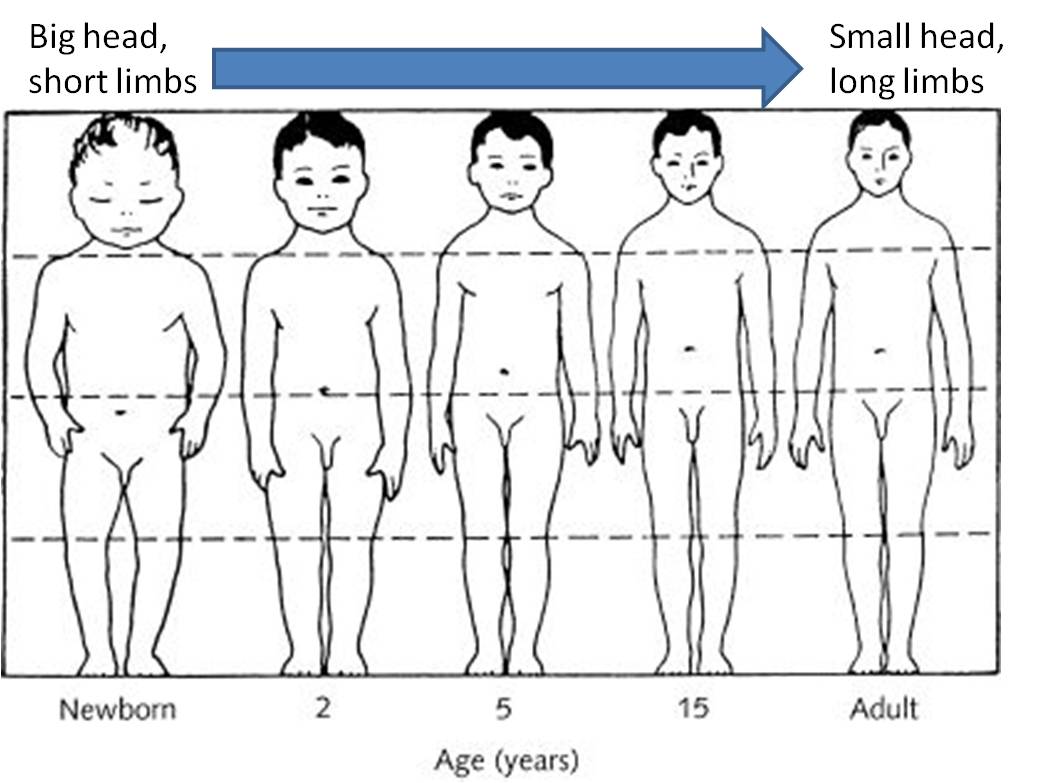 Although
this may seem like an unbridgeable, qualitative difference, they are actually
points along a continuum of morphological and behavioral development. Even within
a single species of primate, like Homo sapiens, we see just as dramatic
a change in morphology and development play out along the trajectory of a single
person's lifetime. Consider the morphological and behavioral differences between
a newborn infant and an adult human. The infant has a large head-to-body ratio,
a small jaw-to-head ratio, and short limbs in proportion to the rest of the
body. Babies have less hair than adults, as well. Likewise, babies are incapable
of the complex behaviors of speech, logic, reasoning, tool-using, and tool-making
that adults can perform. But children are really good at learning. Indeed, all
primates go through these trends during development. It is very interesting
that these are the same trends that distinguish humans from other primates.
In short, these patterns suggest that the genetic difference between humans
and chimps may be in developmental genes - or the genes that regulate the activity
of the developmental changes that occur from infant to adult. Humans grow to
reproductive adulthood, but maintain the "juvenile" conditions of
body proportion and behavioral flexibility. As we know, a small change in developmental
genes can cause a big difference in the final phenotype of the organism. So,
the 1-4% difference between humans and chimps could cause the changes we see,
if those genetic differences are in developmental genes. Again, the way the
species differ, in a manner correlating with developmental changes in primates,
is consistent with this idea.
Although
this may seem like an unbridgeable, qualitative difference, they are actually
points along a continuum of morphological and behavioral development. Even within
a single species of primate, like Homo sapiens, we see just as dramatic
a change in morphology and development play out along the trajectory of a single
person's lifetime. Consider the morphological and behavioral differences between
a newborn infant and an adult human. The infant has a large head-to-body ratio,
a small jaw-to-head ratio, and short limbs in proportion to the rest of the
body. Babies have less hair than adults, as well. Likewise, babies are incapable
of the complex behaviors of speech, logic, reasoning, tool-using, and tool-making
that adults can perform. But children are really good at learning. Indeed, all
primates go through these trends during development. It is very interesting
that these are the same trends that distinguish humans from other primates.
In short, these patterns suggest that the genetic difference between humans
and chimps may be in developmental genes - or the genes that regulate the activity
of the developmental changes that occur from infant to adult. Humans grow to
reproductive adulthood, but maintain the "juvenile" conditions of
body proportion and behavioral flexibility. As we know, a small change in developmental
genes can cause a big difference in the final phenotype of the organism. So,
the 1-4% difference between humans and chimps could cause the changes we see,
if those genetic differences are in developmental genes. Again, the way the
species differ, in a manner correlating with developmental changes in primates,
is consistent with this idea.
b. Genetic
Now that the human and chimp genomes have been sequenced, scientists are seeing where the differences are. One difference is in the HAR-1 gene, which codes for an RNA molecule. This RNA is not translated into a protein, so it is probably a regulatory RNA. Although only 2 bases differ between chimps and chickens, 18 differences occur between humans and chimps. This is much greater than a random process of drift can explain; it is likely that these differences accumulated rapidly in response to selection. Indeed, "HAR" stands for "human accelerated region", describing the rapid change that occurred in this region since the divergence of humans and chimps. Even more intriguing is that the gene for this RNA lies near coding sequences for proteins that influence neural development. So, we may be focusing in on the genes responsible for the rapid shift in neural development that characterize human evolution the behavioral complexity of the human species..
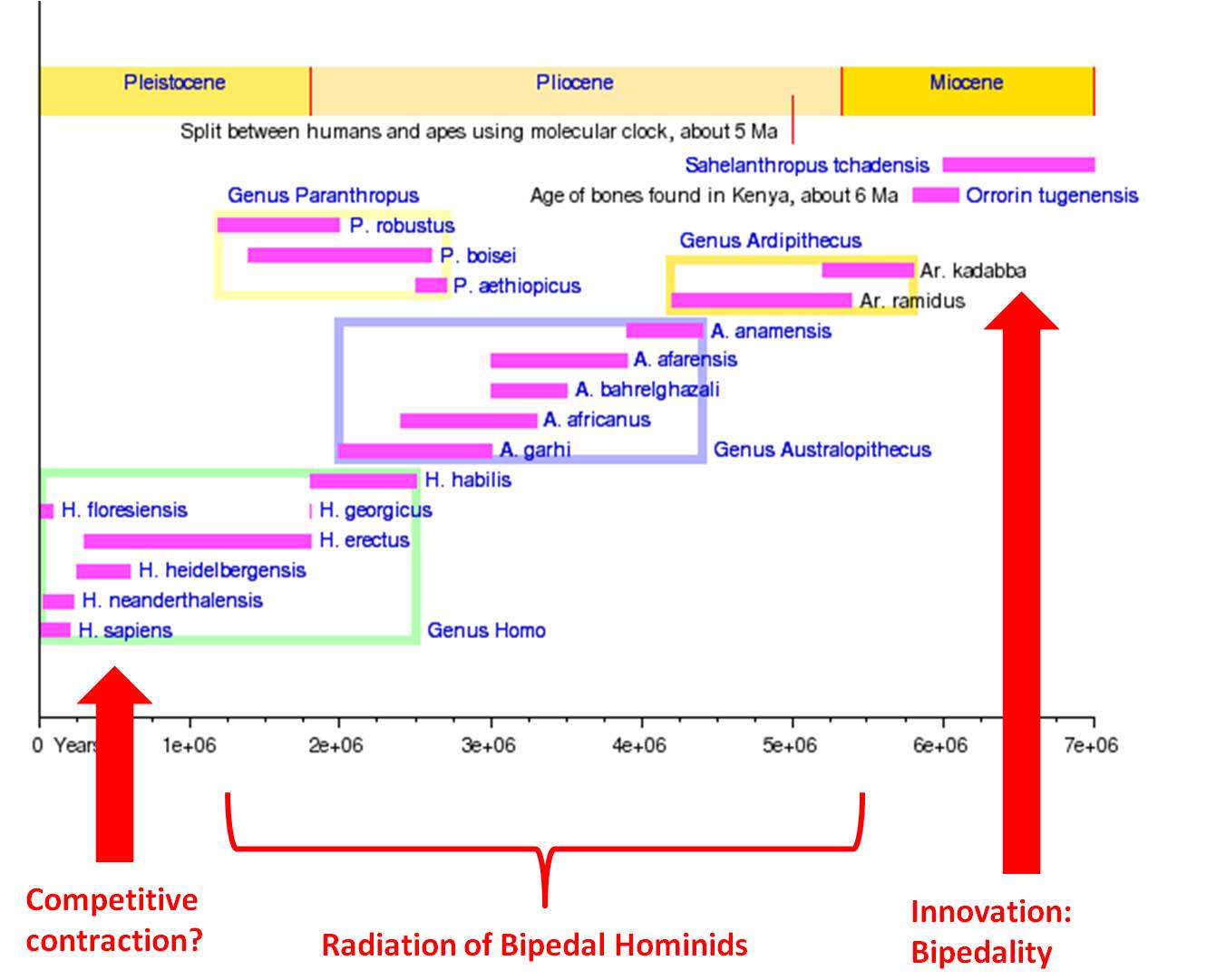 c.
Fossils
c.
Fossils
Because humans are a rather recent evolutionary product, we have a rich fossil history; there has been little time (in geological terms!) for fossils to be destroyed under pressure or recycled by tectonic activity. The major differences that distinguish our lineage from chimps are a large brain and a bipedal gait. These differences did not evolve simultaneously; rather, the fossil record shows us that bipedality evolve much earlier, with a rapid expansion in cranial volume occurring millions of years later. Two questions emerge when we consider the evolution and divergence in any group. Are their potential common ancestors to the species, and are their intermediate fossils mapping the transitions? The rich fossil record of early hominids provides answers to both these questions. Sahelanthropus tchadensis, found in 2001 in Chad, dates to 6-7 mya and may be a common ancestor of the human-chimp clade. Although only a skull exists, it has a primitive mixture of characteristics. Transitional fossil abound, as well. Ardepithecus ramidus, discovered in 1994 but finally described in 2009, is a very complete fossil dating to about 4.5 mya, with critical skeletal elements of the hip, leg, arms, skull, and hands and feet. From the architecture of the skeleton, paleontologists have concluded that this species was typically arboreal (large grasping feet), but was also facultatively bipedal - perhaps walking between trees used for nesting. It is a beautiful intermediate, with both arboreal and bipedal characteristics. More recent fossils (4.5 and 4.0 mya) placed in the genus Australopithecus are exclusively bipedal. A notable species, Australopithecus afarensis, provides striking evidence of this transition. The hips are bowl-like, the femora articulate with the tibia at angles indicative of bipedality, and footprints dating to this period show that these organisms walked erect. They have very small, chimp-sized brains, however; with cranial volumes only 25% the size of modern humans. However, even the skull does show some derived traits, such as smaller canines and a short face (not a long snout like mature chimps).
 After
bipedality evolved, there was a radiation of bipedal forms. Several species,
like A. bahrelgahzali, A. sediba, and Kenyanthropus platyops form a clade that may represent separate species or simply different subspecies
of A. australopithecus. This radiation, however, seemed to stabilize
in two major lineages: a clade of light--bodied, graceful apes established by Australopithecus africanus, and a heavy-bodied, more "robust"
lineage established by Paranthropus aethiopicus. About 2 mya, there
were these two divergent lineages of bipedal hominids in the east African savannah.
The robust lineage produced P. boisei and P. robustus, but
went extinct about 1.25 mya; perhaps due to competitive effects from the the
other bipedal groups. The light-bodied lineage leads to the genus Homo,
from A. garhi to H. habilis, H. erectus, and our
own species, H. sapiens. Cranial expansion occurs in the genus Homo, 2-3 my after bipedality evolved. Even within the genus Homo,
there are several species that may have lived contemporaneously. H. erectus was the first hominid species to leave Africa, radiatating into Europe and Asia.
Back in Africa, ancestral populations of H. heidelbergensis evolved.
Some populations left Africa and diverged into H. neanderthalensis;
other populations remained in Africa and evolved into H. sapiens. Populations
of H. sapiens left Africa later, and may have encountered and displaced H. neanderthalensis in Europe.
After
bipedality evolved, there was a radiation of bipedal forms. Several species,
like A. bahrelgahzali, A. sediba, and Kenyanthropus platyops form a clade that may represent separate species or simply different subspecies
of A. australopithecus. This radiation, however, seemed to stabilize
in two major lineages: a clade of light--bodied, graceful apes established by Australopithecus africanus, and a heavy-bodied, more "robust"
lineage established by Paranthropus aethiopicus. About 2 mya, there
were these two divergent lineages of bipedal hominids in the east African savannah.
The robust lineage produced P. boisei and P. robustus, but
went extinct about 1.25 mya; perhaps due to competitive effects from the the
other bipedal groups. The light-bodied lineage leads to the genus Homo,
from A. garhi to H. habilis, H. erectus, and our
own species, H. sapiens. Cranial expansion occurs in the genus Homo, 2-3 my after bipedality evolved. Even within the genus Homo,
there are several species that may have lived contemporaneously. H. erectus was the first hominid species to leave Africa, radiatating into Europe and Asia.
Back in Africa, ancestral populations of H. heidelbergensis evolved.
Some populations left Africa and diverged into H. neanderthalensis;
other populations remained in Africa and evolved into H. sapiens. Populations
of H. sapiens left Africa later, and may have encountered and displaced H. neanderthalensis in Europe.
So, within our own evolutionary history, we see the patterns of innovation (bipedality and later, brain size), radiation, and (competitive?) contraction.We also see the important effects that small changes in developmental genes can have, and we also see a rich sequence of intermediates that link us with our closest living relatives, the chimpanzees. As Darwin hypothesized, all living things are related. In the last 160 years of biological investigations, scientists have tested and extended Darwin's ideas, and have explained how these changes occur at a genetic level. Hopefully, though the ideas and applications that have been brought forward during this class, you see why Theodosius Dobzhansky - one of the great population geneticists of the 20th century - stated the following, "nothing in biology makes sense except in the light of evolution." Now that you know the evidence for evolution and how evolution works, you are ready to succeed in other biology courses.
Study Questions:
1. What new adaptive zone was 'colonized' when vertebrates evolved jaws?
2. What were the probable benefits of vertebrates colonizing land? When and why did this occur?
3. What is an amniotic egg and what benefit does it provide? Why did amniotes radiate in the Permian?
4. Describe the reproductive differences among the monotremes, marsupials, and placentals. What advantages were there for marsupial and then placental reproductive strategies?
5. Explain how a bird's respiratory system is more efficient than a mammal's.
6. How do humans and chimps differ morphologically?
7. Describe the developmental changes that occur in the growth of a person, and describe how this relates to differences between humans and chimps.
8. What genes might be responsible for the differences beween humans and chimps? Is there any genetic evidence that supports this hypothesis?
9. What is significant about Ardipithecus ramidus?
10. Place these species in the correct temporal order (old to recent): Homo erectus, H. habilis, H. sapiens, A. africanus, A. afarensis.